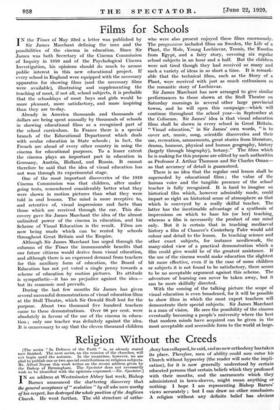Films for Schools
IN . the Times of May 23rd a letter was published by Sir James Marchant defining the uses and the possibilities of the cinema in education. Since Sir James was both Secretary of the Cinema Commission of Inquiry in 1910 and of the Psychological Cinema Investigation, his opinions should do much to arouse public interest in this new educational project. If every school in England were equipped with the necessary apparatus for showing films (and the necessary films were available), illustrating and supplementing the teaching of most, if not all, school subjects, it is probable that the schooldays of most boys and girls would be more pleasant, more satisfactory, and more inspiring than they are to-day.
Already in America thousands and thousands of dollars are being spent annually by thousands of schools in showing educational films as a recognized part of the school curriculum. In France there is a special branch of the Educational Department which deals with ocular education in State schools ; in fact, the French are ahead of every other country in using the cinema for educational purposes. To a lesser extent the cinema plays an important part in education in Germany, Austria, Holland, and Russia. It cannot therefore be said that the idea of visual education has not won through its experimental stage.
One of the most important discoveries of the 1910 Cinema Commission was that children, after under going tests, remembered considerably better what they were shown in motion pictures than what they were told in oral lessons. The mind is more receptive to, and retentive of, visual impressions and facts than those which are received through the ear. This dis- covery gave Sir James Marchant the idea of the almost unlimited power of the cinema in education, and his Scheme of Visual Education is the result. Films are now being made which can be rented by schools throughout Great Britain and the Empire.
Although Sir James Marchant has urged through the columns of the Times the immeasurable benefits that our future citizens would derive from visual education, and although there is an expressed demand from teachers for this auxiliary form of education, the Board of Education has not yet voted a single penny towards a scheme of education by motion pictures. Its attitude is sympathetic—it has no prejudice against the idea— but its economic soul prevails.
During the last few months Sir James has given several successful demonstrations of visual education films at the Stoll Theatre, which Sir Oswald Stoll lent for the purpose. About two thousand five hundred teachers came to these demonstrations. Over 98 per cent. were absolutely in favour of the use of the cinema in educa- tion ; only one teacher was definitely against the idea. It is unnecessary to say that the eleven thousand children who were also present enjoyed these filmy enormously. The programme included films on Sweden, the Life of a Plant, the Mole, Young Lochinvar, Tennis, the Exodus from Egypt, and a fairy story, covering six regular school subjects in, an hour and a half. But the children were not tired though they had received so many" and such a variety of ideas in so short a time. It is remark- able that the technical films, such as the Story of a Plant, were received with just as much enthusiasm as the romantic story of Lochinvar.
Sir James Marchant has now arranged to give similar perfOrmances to those shown at the Stoll Theatre on Saturday mornings in several other large provincial towns, and he will open this campaign—which will continue throughout the school year—in September at the Coliseum. Sir James' idea is that *visual education films shall be shown in every school in Great Britain. " Visual education," in Sir Jarne,s' own words, " is to cover art, music, song, scientific discoveries and their use, recreation, amusements, great stories from literature, drama, humour, physical and human geography, history (largely through biography), botany." The films which he is making for this purpose are edited by such authorities as Professor J. Arthur Thomson and Sir Charles Oman— so that accuracy of detail is guaranteed.
There is no idea that the regular oral lesson shall be superseded by educatiOnal films ; the value of the human voice and the tangible presence of the school teacher is fully recognized. It is hard to imagine an historical film which, however admirably made, could impart so right an historical sense of atmosphere as that which is conveyed by a really skilful teacher. The latter has the inestimable advantage of a synthesis of impressions on which to base his (or her) teaching, whereas a film is necessarily the product of one mind only. But it is certain that in teaching mediaeval history a film of Chaucer's Canterbury Tales would add colour and detail to the lesson. In teaching science and other exact subjects, for instance needlework, the many-sided view of a practical demonstration which a film could give would be of the greatest assistance. If the use of the cinema would make education the slightest bit more effective, even if in the ,case of some children or subjects it is not found to be satisfactory, there seems to be no acceptable argument against this scheme. The adventure of learning can never be taken, away, but it can be more skilfully directed.
With the coming of the talking picture the scope of visual education is even broadened, for it will be possible to show films in which the most expert teachers will demonstrate their special subjects. Sir James Marchant is a man of vision. He sees the possibility of the cinema eventually becoming a people's university where the best that modern minds have acquired can be given in the most acceptable and accessible form to the world at large.












































 Previous page
Previous page